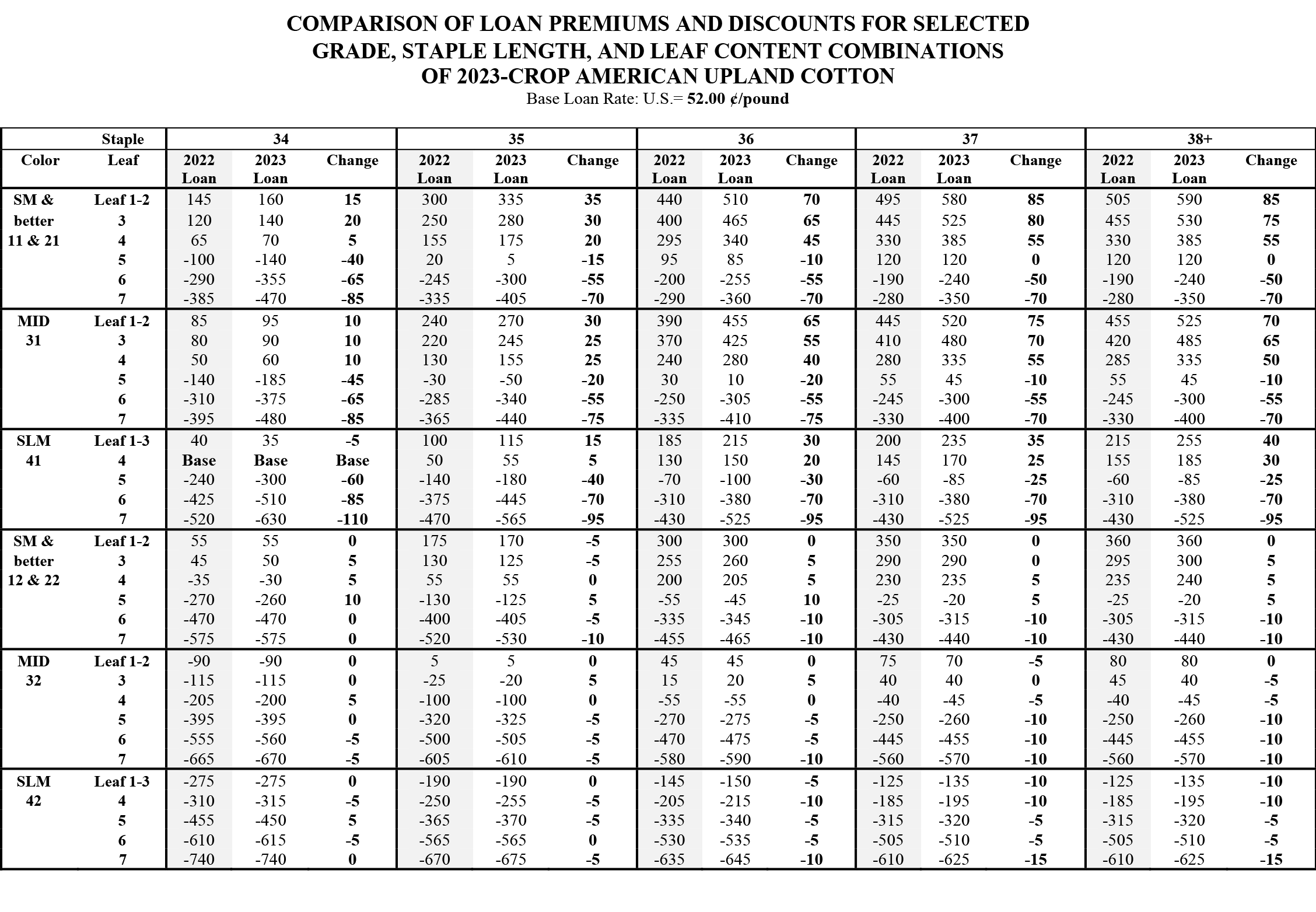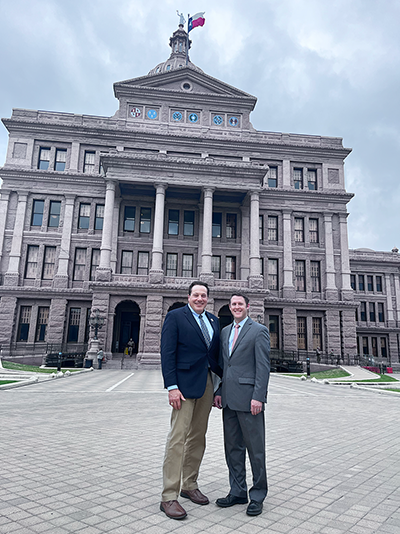Welcome to the April 21, 2023 issue of Cotton News, a service provided by Plains Cotton Growers Inc. for the cotton industry in the Texas High Plains and beyond.
2023 Upland Cotton Loan Chart Reinforces Market Demand for Quality
By Shawn Wade
The USDA Farm Service Agency released the 2023-crop Upland Cotton Loan Premium and Discount tables on April 17.
The new 2023 premium and discount schedule continues to reinforce the market’s emphasis on quality and should reward growers who produce higher quality cotton. The Base Loan rate for 2023 Upland cotton was also announced and remains 52 cents per pound.
The 2023 tables reverse virtually all the changes made in 2022 when premiums and discounts were lowered, especially for White grades 11-41 and Staple lengths 34 and longer. In these Color/Staple combinations the 2023 table adds additional premium for Leaf grades 1-4 and increases discounts for higher leaf measurements.
Beyond the Color/Staple/Leaf tables, the 2023 loan chart maintains the maximum -4000 discount for Level One and Level Two Plastic contamination in the schedule for Extraneous Matter, highlighting the significant problem this situation presents to textile mills and spinners.
For Upland Cotton the 2023 Strength table also includes significant changes for the second time in the past three years. In 2021, growers saw discounts for Strength readings below 25.9 g/tex increased significantly. Those discount levels were mostly unchanged in 2022 but have been bumped up again for 2023 as follows:
• 17.9 g/tex and lower – Discount increased by 100 points.
• 18-18.9 g/tex and 19-19.9 g/tex – Discount increased by 130 points.
• 20-20.9 g/tex and 21-21.9 g/tex – Discount increased by 130 points.
• 22-22.9 g/tex and 23-23.9 g/tex – Discount increased by 120 points.
• 24-24.9 g/tex – Discount increased by 115 points.
• 25-25.9 g/tex – Discount increased by 105 points.
Premium and discount tables for other types of Extraneous Matter, Micronaire and Length Uniformity have mostly smaller 5 to 25-point adjustments in 2023.
The most change in these categories is found in the Micronaire table where discounts for measurements from 3.4 down to 2.7 will have smaller discounts with improvements ranging from 15 to 25 points. The other notable change is for Micronaire between 2.5 and 2.6 where the discount was reduced by 55 points from -1415 to -1360.
Complete 2023 Loan Premium and Discount tables and loan charts with calculated values based on the 2023 schedule of premiums and discounts will be posted on the Resources page of the Plains Cotton Growers website.

The table above provides comparisons between 2022 and 2023 loan values for White Grades 11-41 and Light Spot grades 12-42, Staple 34 through 38 and higher.
Advocacy for Cotton Infrastructure Assistance Continues at State Capitol
By Kody Bessent

South Texas Cotton and Grain Executive Director Jeff Nunley and PCG CEO Kody Bessent.
This week, Plains Cotton Growers, Inc. CEO Kody Bessent and South Texas Cotton and Grain Association Executive Director Jeff Nunley met with state lawmakers in Austin, Texas, to continue advocating for a one-time agriculture disaster relief grant for cotton infrastructure in the state budget.
In 2022, Texas suffered the most significant weather-related damage to crops of all U.S. states with over $6.4 billion in incurred losses — $2.9 billion in damages to cotton alone due to the prolonged drought conditions.
If adopted by the Texas Legislature, eligibility for the grant — subject to a rule — the following conditions are required:
- The purpose of the grant must be to maintain agricultural supply chain resiliency;
- The grant must be for land located on which losses occur in an area within a county identified by the United States Drought Monitor as having a D2 (Extreme Drought) for eight consecutive weeks or D3 (Exceptional Drought) during calendar year 2022; and
- The applicant must demonstrate a decline of at least 30% in gross receipts or gross revenue in calendar year 2022 compared to calendar year 2021.
Individual grants governed by this rider may not exceed $500,000.
This is a big initiative for the cotton industry, and if the agriculture disaster relief grant is adopted, it will go a long way toward maintaining the financial health and viability of the cotton industry until a more permanent risk management tool can be developed.
We are extremely grateful for Sen. Charles Perry (R-District 28) and Rep. Cecil Bell (R-District 3) for carrying this grant rider initiative on behalf of the cotton industry. As conferees have now been appointed this week by both the House and Senate, we look forward to working with them in the final stretches of the budget process to secure this critical funding initiative.
In Case You Missed It
High Plains Planting Conditions Forecast
USDA Releases Report Showing the Use of Cotton by Consumers
Crop Progress — 2023 Cotton Season Underway
Drought Continues to Plague Texas, Preplant Rain Needed
Lone Star Leadership for Cotton
USDA Announces Grassland Conservation Reserve Program Signup for 2023